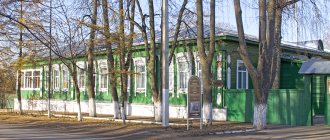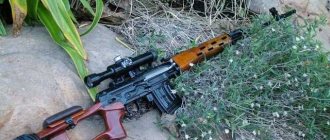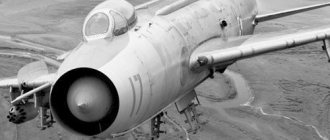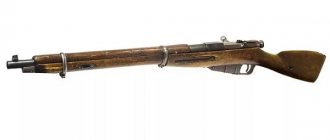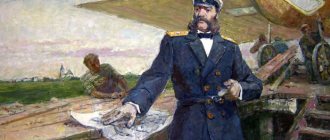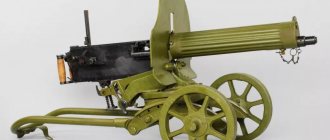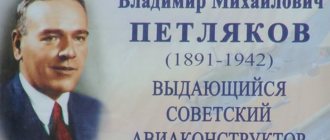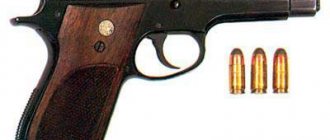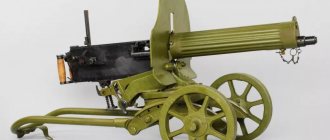Childhood and youth
Shpagin was born in April 1897 in the village of Klyushnikovo into a peasant family. In addition to him, his parents - father Semyon Venediktovich and mother Akulina Ivanovna - had three more children: son Fedor and daughters Anna and Elena.
Published by Boris Mexa Monday, April 29, 2019
PPSh designer Georgy Shpagin
After studying at a three-year school, the boy started working in a carpenter's artel at the age of 12 - he had to help his family. One day, while making a part, the teenager injured his right hand. A broken chisel cut the tendons of the index finger of the future designer.
The finger remained inactive for the rest of his life. Later, George was sent to a merchant's shop as a “boy.” The conditions in which the future developer found himself were difficult: there was not enough proper nutrition and time for rest. Having escaped from there, the teenager got a job at a glass factory.
First developments
Vladimir Fedorov - and the head of the experimental workshop, Vasily Degtyarev, drew attention to the mechanic . Shpagin had all the makings of a person capable of not only carrying out other people’s tasks, but also independently creating something new. In 1922, Shpagin completed his first independent development: a ball mount for a tank machine gun designed by Fedorov.
Later, together with Degtyarev, he began to develop machine guns. In 1931, the Red Army received a 12.7-mm Degtyarev heavy machine gun (DK), during the operation of which shortcomings and shortcomings were identified.
Georgy Shpagin was involved in improving the machine gun. In particular, he created an original tape power module. In 1939, the modified design entered service under the name “12.7 mm Degtyarev-Shpagin heavy machine gun model 1938 - DShK.”
Power called DShK. Unique heavy machine gun of the Red Army Read more
Personal life
The engineer's personal life was spent in love. Georgy Semenovich married a fellow villager, a girl named Evdokia Dvornikova. Shpagin's future wife was born into a wealthy peasant family, and the beauty's father for a long time did not give the young groom consent to marry his daughter. But the guy's feelings were so strong that it did not change his intentions. The designer lived with Evdokia Pavlovna until his death.
The couple had 4 daughters. The wife outlived the man by 40 years. Shpagin's father-in-law, Pavel Prokhorovich, was under investigation by the NKVD in 1933, later lost his right to vote and went into exile for 3 years. However, because of this, Georgy himself did not become a victim of the mass terror of the late 1930s, and subsequently had access to classified materials.
Weapons revolution
During the war with Finland of 1939-1940, it became obvious that the Red Army was in dire need of automatic weapons capable of providing infantry with a density of fire at a distance of several tens of meters. The army was already armed with Tokarev automatic rifles, but they were good at long-range shooting, had a small magazine capacity, and were also too long for combat in trenches or in buildings. In addition, the cartridge used in the rifles was too powerful: the recoil reduced the already small percentage of hits when firing in bursts, the design requirements increased, the weapon became too heavy for soldiers who were forced to literally run or walk with it all day long. It seemed optimal to arm the army with a complex of a self-loading rifle + submachine gun (an automatic weapon chambered for a relatively low-power pistol cartridge, but sufficient to defeat the enemy).
Article on the topic
The first after Stalin. The gunsmith Degtyarev could supply an entire army. In 1940, the People's Commissariat of Armaments gave technical instructions to gunsmiths to create a submachine gun, similar or superior in tactical and technical characteristics to the already existing Degtyarev submachine gun, but more technologically advanced and adapted for mass production. The Second World War was already raging in Europe, and it was obvious that the USSR would inevitably be drawn into it. Under these conditions, the task for designers was extremely complicated: the submachine gun had to be developed in the shortest possible time.
Shpagin not only coped with the task, but also made a real revolution. He managed not only to provide the required level of reliability, but also to simplify the production process as much as possible. For the first time in domestic small arms, almost all metal parts were made by stamping, and wooden ones had a simple configuration. This made it possible, in wartime conditions, to produce submachine guns even by low-skilled workers, which was of great importance during the mass mobilization of the male population into the army.
The Shpagin submachine gun (PPSh) chambered for 7.62x25 mm (the same used in the TT pistol) was put into service in December 1940.
Career
In 1916, the young man was called up to serve in the tsarist army. The young man was sent to the 14th Grenadier Regiment, but due to an injured index finger, Shpagin could not perform military duties. Then he was transferred to work in the weapons workshop. Here Georgy became acquainted with samples of Russian and foreign weapons.
A year later, the young specialist, who had managed to show his talent, went to serve in artillery workshops. After demobilization in 1918, he returned to Klyushnikovo, and soon became a member of the Red Army and took the place of gunsmith of the Vladimir garrison. A few years later he began working as a mechanic in the workshop of the Kovrov arms and machine gun plant.
Georgy Shpagin and Vasily Degtyarev / Izvestia
At this enterprise, designers Vladimir Grigorievich Fedorov and Vasily Alekseevich Degtyarev were already developing projects. The young man soon began to offer fresh ideas to improve the finished models. So, in the design of magazines for Fedorov’s assault rifle, the guy came up with a different arrangement of rivets, reducing their number and thereby reducing production costs.
At the same time, the strength of the product remained the same. In 1922, Georgy Semenovich was entrusted with his own development - a ball mount for a coaxial machine gun created by Vladimir Grigorievich. A significant project in Shpagin’s biography was the modernization of the Degtyarev 12.7 mm machine gun, which is classified as a large-caliber weapon.
At that time, the model was discontinued, revealing a number of shortcomings. By 1939, the Soviet designer had eliminated the shortcomings of the product. Now weapons began to be produced by the Red Army under the abbreviation DShK (Degtyarev-Shpagin machine gun).
In the early 1940s, mass production of these samples began. In addition, Georgy Semenovich participated in a project to install a Fedorov-Shpagin coaxial light machine gun in one of the models of Soviet tanks. The designer’s ideas made it possible to simplify the ball installation system, as well as the socket device.
The inventor became famous for his development of a submachine gun (PPSh), which the man designed in 1940. Compared to the previous PPD model, the sample turned out to be more versatile and cheaper. During the war, these small arms became the most widely produced.
Monument to Shpagin on Lenin Ave. Georgy Semyonovich Shpagin (April 17 [29], 1897, village of Klyushnikovo, now Kovrov district...
Published by Kovrov City Wednesday, December 9, 2015
Monument to Georgy Shpagin
The design was distinguished by the fact that the metal parts were stamped, and the wooden parts had a simplified configuration. In the context of military events, as well as taking into account the low qualifications of the craftsmen producing PPSh, such a development turned out to be indispensable. In 1943, the designer created a signal pistol (SPSh).
During the Great Patriotic War, Shpagin worked at a machine-building plant in the Kirov region. The engineer's invention became a sign of memory. He was depicted in monumental sculpture, paintings and other works of art.
After creating the submachine gun, Georgy Semenovich reworked its design, making it universal. The product withstood frost and heat, continuing to work flawlessly and allowing soldiers to perform feats. It is no coincidence that the PPSh was popularly called the “weapon of victory.”
Georgy Semenovich Shpagin was born on April 21, 1897 in the village of Klyushnikovo, Kovrovsky district, Vladimir province, now Kovrovsky district, Vladimir region.
From the family of a retired soldier from the peasant village of Klyushnikovo, Semyon Venediktovich Shpagin and his wife Akilina Ivanovna. On the same day, April 21, the baby was baptized with the name Georgy by the priest of the Medushi churchyard in Kovrov district, Dmitry Pokrovsky, with psalm-reader Ivan Polisadov. He graduated from the 3rd grade of the parish school in 1909. He and his father went to Kovrov to earn money. Forced to help his family, he began to earn a living from the age of 12, worked in a carpentry artel in the city of Kovrov, but due to damage to the tendon of the index finger of his right hand by a chisel, he was forced to leave this craft. In 1910, he was sent as a “boy” to a merchant’s shop in the city of Rylsk, Kursk province. After a conflict due to the merchant’s tyranny, he left him in 1911, worked at a glass factory in the city of Sudogda, Vladimir province, and then worked for hire in his native village. In May 1916, Georgy Shpagin was drafted into the Russian Imperial Army. He served as a junior gunsmith in the regimental weapons workshop of the 14th Georgian Grenadier Regiment on the Western Front. Being inquisitive, Shpagin quickly studied the Nagan revolver, the three-line Mosin rifle, the Maxim heavy machine gun, and light machine guns of foreign systems. The skillful hands, ingenuity and initiative of the young gunsmith contributed to the fact that a year later in 1917, as an excellent gunsmith, he was transferred to artillery workshops. At the beginning of 1918 he was demobilized and returned to his native village. During the Civil War, in November 1918, he joined the Red Army. He served as a weapons captain and gunsmith in the 8th Infantry Regiment (Vladimir Garrison). In 1919 he was demobilized due to illness. At the time of demobilization he had the rank of captain. In 1920 G.S. Shpagin enters the experimental workshop of the Kovrov Arms and Machine Gun Plant No. 2 (since 1932 “Kirkizh”), where V.G. worked at that time as a mechanic. Fedorov and V.A. Degtyarev. Automatic machine of the Fedorov Model 1916 system (caliber 6.5 mm)
The first thing Shpagin began working in the workshop with was assembling magazines for Fedorov assault rifles. 1916. Soon he proposed to simplify the assembly of the store by reducing the number of rivets and placing them so that the strength of the store box did not decrease, but the weight decreased. Creativity at work and the ingenuity of Georgy Semenovich attracted the close attention of the plant director, engineer Fedorov, and the head of the experimental workshop, Degtyarev. He was allowed to work on the machines himself, and then young workers were assigned for training. Successes inspired the young designer and strengthened his faith in his own abilities. His first developments included the design of a ball mount for a coaxial 6.5 mm Fedorov-Ivanov tank machine gun. This work served as the basis for Shpagin’s subsequent creation of a ball mount for mounting a 7.62 mm DT tank machine gun in tanks, armored vehicles, and armored platforms. In 1924 - 1926 Shpagin actively worked together with Degtyarev on the creation of a light machine gun. Since that time, Shpagin has been entrusted with the development of critical components and new systems of automatic small arms.
Coaxial 6.5-mm tank machine gun Fedorov-Shpagin-Ivanov 1924. Mounted on the MS-1 and T-12-1 tanks.
Thanks to hard work, a talented genius grew into an outstanding weapons designer. In 1931, he was appointed designer at the same plant No. 2. In 1931, Degtyarev invited Shpagin to work on the design of his heavy machine gun DK-32. This work became one of the most important stages in the development of Georgy Semenovich as a weapons designer. He acted not only as an assistant to his teacher, but also as a co-author. For Degtyarev's 12.7 mm heavy machine gun, Shpagin proposed an original power supply system, consisting of a drum-type receiver and a metal cartridge non-scattered power supply belt. In 1938, the Red Army and Navy received a truly effective and very effective military air defense weapon under the name “12.7-mm heavy machine gun Degtyarev-Shpagin model 1938.” The new machine gun immediately received an excellent rating from the troops. Georgy Semenovich was awarded the first state award - the Order of the Red Star - for his success in creating new types of weapons and military equipment. In 1939-1940, Shpagin created a new submachine gun PPSh-41, which glorified the name of its creator and became the main manual automatic weapon of the Red Army during the Great Patriotic War. On December 21, 1940, the Defense Committee of the Council of People's Commissars of the USSR adopted a resolution on the adoption of a new weapon into service by the Soviet Army, giving it the name “7.62 mm submachine gun of the Shpagin system, model 1941 (PPSh-41).” With the beginning of the Great Patriotic War, mass production of PPSh was launched in many cities of the country. This submachine gun amazed with the simplicity and simplicity of its design, the abundance of new design solutions, and good performance characteristics. Of particular importance, especially during the war years, were the exceptionally high production and economic indicators of the new weapons. First of all, this concerned a significant reduction in labor costs for its production. The production of the Shpagin submachine gun required 13.9 kg of metal and from 5.6 to 7.3-7.8 (depending on production capacity) machine-hours. Only the barrel of the weapon was subjected to careful finishing on metalworking machines; the remaining metal parts were made by cold stamping using spot and electric arc welding. The design of the Shpagin submachine gun almost completely lacked precision press fits and had far fewer threaded connections. In general, the weapon turned out to be so simple that its production could be mastered at any, including non-specialized machine-building plants with press-stamping equipment with a capacity of no more than 70-80 tons. In terms of its reliability, the PPSh was in no way inferior to similar weapons of other warring armies.
In March 1941, he was transferred to the position of chief designer at plant No. 367 of the People's Commissariat of Armaments of the USSR (the city of Zagorsk, Moscow region). The first to produce PPSh in July 1941 was the NKV USSR plant in Zagorsk, Moscow Region, originally intended for the production of PPSh. The first batch of Shpagin submachine guns was tested at the front directly in battle. The results exceeded all expectations. Enthusiastic reviews came from the headquarters of units and formations; commanders asked to establish mass production of PPSh. In October 1941, due to the rapid advance of German troops towards the capital, the arms factory was evacuated to the city of Vyatskie Polyany, Kirov region, where a new production was organized on the basis of an unfinished bobbin factory. Another plant that produced drum magazines for PPSh was also evacuated here from the village of Lopasnya near Moscow. Shpagin was appointed chief designer of this plant, which became the head plant for the production of PPSh for the Red Army. The Vyatsko-Polyansky Machine-Building Plant worked very closely in cooperation with the Izhevsk metallurgical and machine-building plants, which provided it with metal, barrel blanks, a significant amount of necessary tools, equipment, etc.
Comparative field tests of it with the best foreign models, which took place in December 1941, showed the advantages of the Soviet model - simple in design, lightweight, convenient for combat use. During the war, gunsmiths from Vyatskiye Polyany produced more than two million PPSh. The significant needs of the Red Army for these powerful weapons were the main reason that many non-specialized machine-building plants began their mass production, including in Voroshilovgrad, Zlatoust, Kovrov, and Tbilisi. However, Moscow became the second main center for the production of PPSh during the war. If in November the workers of the capital gave the front the first 400 PPSh, then in December, at the height of the battle for Moscow, Soviet soldiers received 14,000 Shpagin submachine guns. During the war, Muscovites produced more than 3.5 million submachine guns designed by Shpagin. In total, over the four years of the Great Patriotic War, the Soviet defense industry produced 5.4 million PPSh mod. 1941 It is impossible not to mention international cooperation in the production of small arms for the Red Army. We are talking about the Tehran Machine Gun Factory. In 1942, after the signing of an intergovernmental agreement, the Iranians were given all the technical documentation, necessary equipment and accessories for the manufacture of PPSh submachine guns under Soviet license. During the war, our soldiers received several tens of thousands of Iranian-made PPSh. Shpagin's submachine guns deprived the fascist invaders of their advantage over the Red Army in automatic small arms. Georgy Semenovich was awarded the Stalin Prize of the first degree for the creation of a submachine gun, and he was awarded the Order of Lenin. Already during the war, the design of the PPSh underwent some changes, due to both accumulated combat experience and the modernization of mass production. As a result, it was possible not only to reduce the cost of PPSh from 500 rubles. in 1941 to 142 rubles. in 1943, i.e. 3.5 times, and simplify its production, but also improve the functioning of the automation system in the most difficult operating conditions. Thousands of Red Army soldiers and commanders thanked the designer for his excellent weapon. For example, in 1945, Georgy Semenovich received a letter from the active army: “Dear comrade Shpagin! I sincerely thank you for the wonderful weapon - the PPSh assault rifle. I have been fighting with him for four years, and he has never refused me a fight. I walked with him from Moscow to Silesia and I’m thinking of going to Berlin. With soldier’s greetings, Private Ivan Petrov.”
Shpagin Georgy Semenovich
Continued G.S. Shpagin and design work. Along with the creation of submachine guns, Shpagin during the war years was also involved in the design of signal pistols (rocket launchers) of simplified designs, created using the latest technologies of the time - stamping and welding. In 1943, the 26-mm Shpagin signal (lighting) pistol (OPSH-1), intended for launching lighting and signal cartridges, was adopted by the Red Army. In the same year, its design was significantly modernized, and the Red Army soldiers received a new, more effective 26-mm Shpagin signal pistol (SPSh-2). Later, on its basis, an aviation version of a 40-mm rocket launcher was created (1944), which was used to send signals from an aircraft for the purpose of recognizing “friend or foe.” SPS signal pistols of a surprisingly simple and reliable design and to this day, 58 years after being put into service, still continue to faithfully serve, not only in the Russian Armed Forces and the armies of the CIS member states, but also in the armies of former countries - members of the Warsaw Pact, as well as many third world countries. For the creation of the signal pistol, Shpagin was awarded the second Order of Lenin. Weapons created by G.S. Shpagin, was successfully used by Soviet soldiers on all fronts of the Great Patriotic War. The DShK heavy machine gun has proven itself to be a reliable fire weapon for air defense and combat against mechanized enemy units. Along with the activities of a weapons designer, G.S. Shpagin carried out a great deal of public and government work. In 1935 he was elected a member of the All-Russian Central Executive Committee. Member of the CPSU(b) since 1944. In 1946 - deputy of the Supreme Soviet of the USSR of the 2nd convocation. For services to the Motherland and the Armed Forces, he was awarded the title of State Prize laureate (1941). For outstanding services in organizing the production of aircraft, tanks, engines, weapons and ammunition, as well as for the creation and development of new types of military equipment and providing them to the Red Army and Navy during the Great Patriotic War by Decree of the Presidium of the Supreme Soviet of the USSR of September 16 In 1945, Shpagin Georgy Semenovich was awarded the title of Hero of Socialist Labor with the Order of Lenin and the Hammer and Sickle gold medal. After the war, he became seriously ill (stomach cancer) and was forced to stop his design activities. He was elected as a deputy of the Supreme Soviet of the USSR of the 2nd convocation (1946-1950). Since 1951 he lived in Moscow. Died on February 6, 1952. He was buried at the Novodevichy cemetery in Moscow. Awarded 3 orders of Lenin (01/18/1942, 08/5/1944, 09/16/1945), orders of Suvorov 2nd degree (11/18/1944), Red Star (02/21/1933), medals. Laureate of the USSR Stalin Prize (1941). Memory: - In 1982, machine builders opened a memorial house-museum in the city of Vyatskie Polyany. It is an ordinary wooden hut, standing on a high cliff in the old part of the city. In the same city, one of the streets is named after him. — A memorial plaque was installed on the mechanical engineering building in honor of the designer. — The monument was erected in the city of Vyatskie Polyany, Kirov region. — In 1986, a bronze bust of G.S. was installed in Kovrov, Vladimir region. Shpagina.
Monument to G.S. Shpagin in Kovrov. Crossing the avenue Lenina from st. Lepse.
— The name of the designer is immortalized on a stele for gunsmith designers on the territory of the Degtyarev plant in the city of Kovrov.
Stele for gunsmith designers on the territory of the plant named after. Degtyareva in the mountains. Kovrov. On the stele are bas-reliefs of gunsmith designers: Vladimir Grigorievich Fedorov, Vasily Alekseevich Degtyarev, Georgy Semenovich Shpagin, Semyon Vladimirovich Vladimirov, Sergei Gavrilovich Simonov, Pyotr Maksimovich Goryunov, Mikhail Timofeevich Kalashnikov, Vasily Petrovich Gryazev, Arkad Shipunov Ia Grigorievich, Richter Aron Abramovich, Nudelman Alexander Emmanuilovich .
— In 2013, his name was assigned to the Krutovskaya basic secondary school in the Vladimir region.
Coin of the Bank of Russia of the series “Weapons of the Great Victory (weapon designers)”, 25 rubles 2022, G.S. Shpagin, Shpagin submachine gun.
Source: - Calendar of significant and memorable dates of the Vladimir region for 2022. – Vladimir, 2016. – pp. 30-32.
The word of a Russian gunsmith
About how the most famous machine gun of the Second World War was created, G.S.
Shpagin spoke at the height of the fierce fighting on the Kursk Bulge in the article “The Word of a Russian Gunsmith” in the newspaper Izvestia on July 8, 1943. The word of a Russian gunsmith - I am often asked: how long did I work on creating my submachine gun? No, not long. I thought a lot about what an automatic weapon should be, what advantages it should have over existing systems in order for a Red Army soldier to appreciate it, and moreover, to love it. I carefully studied existing small arms systems, including automatic ones, had frequent and long conversations with soldiers and commanders, listened carefully to their opinions and assessments, and gradually I developed and grew the idea of a new type and type of machine gun. In one of the units, a Red Army soldier complained that some types of submachine guns that preceded the PPSh are difficult to disassemble and assemble, that this operation and cleaning takes at least half an hour, that it is difficult to clean such weapons, that there are many threads in them connections and that, finally, there are so many details in it that all these dozens of names are difficult to learn and remember. He was right. The mass of troops spoke through his lips. And I made the first conclusion for myself - the machine gun should be extremely simple, extremely accessible for mastering by an ordinary soldier, often a village boy. Knowing our industry and the gigantic tasks that were and are facing it, from the very beginning I set myself the goal that the new automatic weapon should be extremely simple and uncomplicated in production, so that semi-skilled and even semi-skilled workers would be employed in its manufacture. It seemed to me that a design of the machine should be created, the implementation of which on a wide production scale would not require a significant number of complex and precise machines. If we really arm the huge Red Army with automatic weapons, I thought, and try to do this on the basis of the previously adopted complex and labor-intensive technology, then what an incredible fleet of machines would need to be loaded, what a huge mass of people would need to be assigned to these machines. So I came up with the idea of creating a stamped-welded design of the apparatus. I must tell the truth that even experts in weapons production did not believe in the possibility of creating a stamp-welded machine gun and laughed at me in my eyes and behind my eyes: Shpagin, they say, is fantasizing... But I was convinced that my idea was correct. And since it was correct, I did not intend to deviate from it. I decided for myself that the durability of the machine gun should be significantly increased, the guaranteed number of shots should be multiplied. And moreover, there should be no spare parts for the machine, so that there would be no need for them, and also that disassembly and assembly should be carried out without tools. And another aspect of the matter attracted me. I wanted the new machine gun to be light, comfortable, to achieve streamlining of the greatest number of parts, so that it would be “sleek,” as aviation experts say, so that its appearance would attract the eye. Let me put it briefly - I wanted the army to love my PPSh, so that the fighter would wear it on his chest as a reliable, expensive and pleasant thing, so that he would love my submachine gun and believe in it. This was my dream, this is what I was striving for... The PPSh became the first type of small arms to use stamping, arc and spot electric welding, which reduced labor-intensive mechanical processes. The submachine gun completely lacked threaded connections and press nozzles; the new technical process ensured greater savings in metal and shortened the production cycle. Thanks to its simplicity of design and trouble-free automation, the PPSh quickly gained good reputation in the armed forces. “Dear comrade Shpagin! I sincerely thank you for the wonderful weapon - the PPSh assault rifle. I have been fighting with him for four years, and he has never refused me a fight. I walked with him from Moscow to Silesia and I’m thinking of going to Berlin. With soldier's greetings, Private Ivan Petrov." This is just one of the many letters that came from the fronts during the Great Patriotic War to the designer and gunsmith G.S. Shpagina. His submachine gun was appreciated already in the first battles - near Moscow. In 1941, for the creation of the machine gun G.S. Shpagin was awarded the State Prize of the 1st degree and the Order of Lenin. Source of publication: Newspaper “DEGTYAREVETS” No. 12 dated March 25, 2020, page 11. Kovrov and Kovrov workers during the Great Patriotic War Vladimir region during the Great Patriotic War Kovrov gunsmiths: - Vladimir Grigorievich Fedorov (1874-1966), designer. — Degtyarev Vasily Alekseevich (1879-1949), designer. — Simonov Sergey Gavrilovich (1894-1986), designer. — Vladimirov Semyon Vladimirovich (1895-1956), designer. — Shpagin Georgy Semenovich (1897-1952), designer. — Goryunov Pyotr Maksimovich (1903-1943), designer. — Mikhail Mikhailovich Goryunov (1912–1991) — Soviet weapons designer — Vasily Efimovich Voronkov (1899–1976) — Soviet weapons designer
